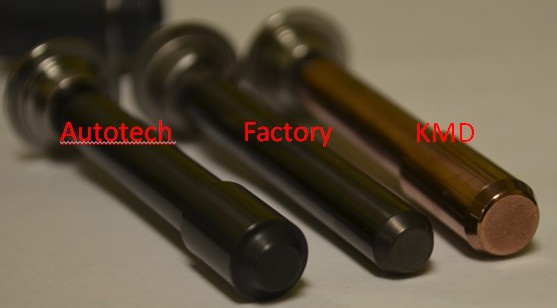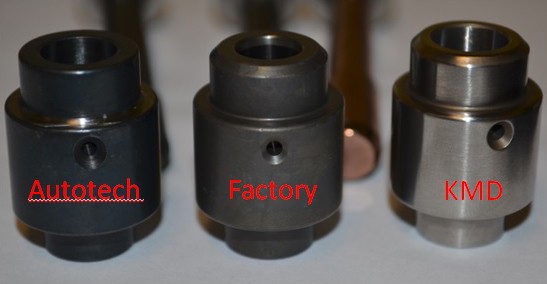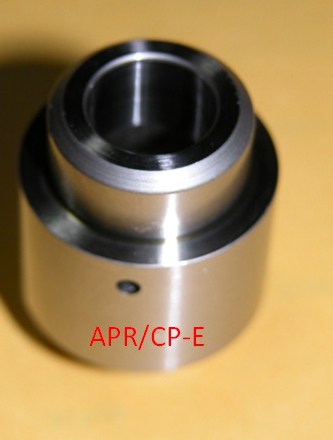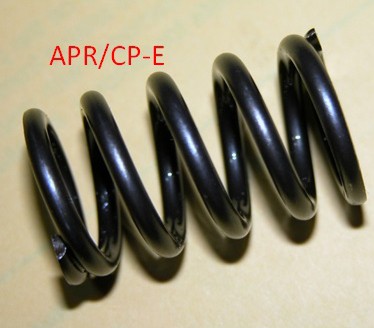In part 1 we discussed fuel pumps, their uses and what’s inside them. Now we can talk a little about what goes into making them and what the differences are.
Does size matter? When looking at the stock piston on the factory fuel pump you can sure say that it does matter. If you increase the piston diameter you increase the flow of the pump. We have decided to compare the similar internals first and then compare the APR pump afterwards. The Autotech/KMD internals use the same diameter piston head. At 9.8mm compared to the factory 8.0mm. When comparing the volume area they are both about 50% improvement with the KMD edging out the Autotech by a marginal amount. This slight edge comes from the shape of the end of the shaft being slightly different. The Autotech looks more like a piston from an internal combustion engine where the KMD is very similar to the factory design at the end. Because these are the older version of the KMD internals they are coated differently. They look to be a TiCN coating but we can’t say for sure. The Autotech internals are listed as a DLC coating which stands for Diamond Like Carbon. The newer KMDs are now PVD coated (Physical Vapor Deposition).
When we start comparing the sleeves that the piston rides in we notice they are all similar in shape and size. The Autotech has a coated sleeve that appears to be some sort of tool steel. The factory is uncoated and appears to be tool steel. The KMD is uncoated and appears to be stainless of some variety. Internally there is a relief cut that is ~3 times larger on the aftermarket internals which should help with the 50% improvement in flow. The sleeve shows the constraints for why you can not go much larger than the 9.8mm piston. The end that fits in the factory pump can only be so large and the wall thickness must maintain a certain size or failure will be imminent.
For a long time the CP-E pump was rumored to be made by APR. The CP-E pump we ordered actually came with an APR sticker on the side of it. Oops. We quickly disassembled it and documented the findings. The pump uses a 9.5mm piston which is smaller then the two internal only options. APR claims 40% improvement and we calculated about a 41% improvement so no issues there. They also chose a Stainless steel sleeve and DLC coating on the piston. The big difference comes when you look in the cap. They machine in an extra Seal to help with the oil deposit issue. Is this needed? We aren’t sure yet but it is an interesting addition.
Now for the one big addition that only one manufacturer saw fit to think about. APR added a spring that increases the ability to return the piston. This can be very important for wear on the cam shaft if you get any float from the spring at higher RPM’s; the more the pump worked, the more important this would be. Remember that the cam has three lobes on it so even though the cams spin at half the speed of the crank the pump spins at three times that of the cam. This makes a 1.5 times the crank difference. So what ever the RPM you are at the pump is at 1.5 times that. At a 8000rpm redline the pump is going 12000rpms. The pump also has to draw in 40-50% more fluid so a return spring plays apart in that as well.
Next time we will get these pumps on the dyno and check out how the hold pressures at the same load. Luckily we have an in house dyno that can vary load and the ability to log pressures.








Why no ptp internals?
Because John
Great info!!! Especially for one that may be needing to go this direction shortly. It will be interesting too see how each internals hold up to the pressure and which, for now, comes out ahead!!!
I’m curious to see how it all holds out. Especially considering Autotech has yet to do a “revision” and KMD has already 4 or 5. I couldn’t find anything but I don’t think CP-E has done any revisions either.
Can you also test the increased load placed on the pump cam follower that is a result of the increased APR spring pressure? I know the higher pump displacement is the primary increase in resistance, but I was just wondering how much added pressure is supplied via the stiffer spring on such a small surface area.
On many direct injected engines the cam follower between the cam and the pump wear at an accelerated rate. This results in larger wear particles which are not always caught by the oil filter or are unfiltered when in bypass mode and seem to tear up the bottom end bearings as noted in UOA’s. It is also noted in the following PP Presentation around slide 29:
https://opensiuc.lib.siu.edu/cgi/viewcontent.cgi?article=1024&context=auto_pres&sei-redir=1&referer=http%3A%2F%2Fsearch.yahoo.com%2Fsearch%3B_ylt%3DA0oG7kEX5XpR_l8AwmhXNyoA%3Fp%3Ddirect%2520injected%2520cam%2520follower%2520%26fr2%3Dsb-top%26fr%3Dyfp-t-900#search=%22direct%20injected%20cam%20follower%22
So when did CPE started out sorting there fuel pumps I got mine almos 2 yrs ago and I believe it was done at CPE. I might be wrong just wondering
Kmd and auto tech reuse the factory spring, APR is no different.
It would be interesting to see if the spring rate us higher on the apr.
awesome info plz do a dyno comparison and long term update!! i am in need of a HPFP but i just haven’t made up my mind yet.
whens part 3 coming?